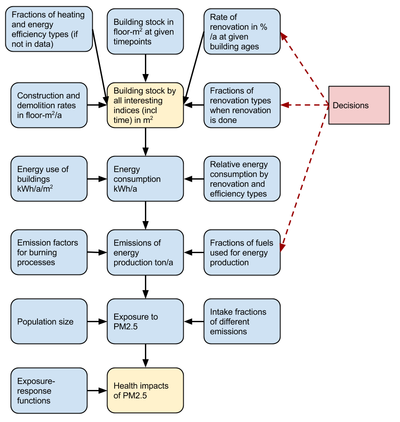Building model: Difference between revisions
Jump to navigation
Jump to search
(→Calculations: buildings still need bug fix) |
|||
| Line 35: | Line 35: | ||
)), | )), | ||
formula = function(...) { | formula = function(...) { | ||
# ######## Current building stock | |||
# stock <- stockBuildings * heatingShares * efficiencyShares | |||
# #### Changes in building stock due to construction etc. | |||
# | # change <- timepoints(changeBuildings, obsyear, sumtimecol = FALSE) # Cumulative changes at certain timepoints. | ||
#### Calculate cb ie. those buildings that were built between Time-1 and Time. | |||
#### This has two parts: the stock (stockBuildings) is treated as net construction rate | |||
#### by assuming that after construction Time nothing is demolished. | |||
#### Then this is added to the direct construction data (changeBuildings). | |||
# ### This code can be used to change cumulative building stock data to construction rates of periods. | |||
# stockBuildings@output$Time <- as.numeric(as.character(stockBuildings@output$Time)) | |||
# years <- sort(unique(stockBuildings@output$Time)) | |||
# cb <- stockBuildings | |||
# cb@output$Time <- years[match(cb@output$Time, years) + 1] # Frame shift with time, years 2:n. | |||
# cb@output <- subset(cb@output, !is.na(Time)) | |||
# cb <- stockBuildings - cb | |||
# cb@output <- orbind(cb, subset(stockBuildings@output, Time = years[1])) # First year | |||
cb <- stockBuildings * heatingShares * efficiencyShares | |||
# colnames(cb@output)[colnames(cb@output) == "Time"] <- "Startyear" | |||
# | |||
# Add buildings from stock and buildings from construction data | |||
cb <- orbind2(cb, changeBuildings) | |||
########### | ########### Renovations of existing buildings. # Combine with (continuous) index Age. | ||
reno <- | |||
reno <- cb * renovationShares | |||
marginals <- colnames(reno@output)[reno@marginal] | marginals <- colnames(reno@output)[reno@marginal] | ||
reno@output$Age <- as.numeric(as.character(reno@output$ | reno@output$Age <- as.numeric(as.character(reno@output$Startyear)) - # Startyear is the time of renovation | ||
as.numeric(as.character(reno@output$ | as.numeric(as.character(reno@output$Time)) # Time is the time of construction | ||
reno@marginal <- colnames(reno@output) %in% marginals | reno@marginal <- colnames(reno@output) %in% marginals | ||
reno <- reno * | reno@output <- reno@output[result(reno) != 0 , ] # Zeros are meaningless | ||
reno <- reno * renovationRate # continuousOps(reno, renovationRate, '*') FIX continuousOps before using | |||
# reno@output$Startyear <- reno@output$Time # Renovation is the new event. | |||
reno <- oapply(reno, cols = c("Age", "Time"), FUN = sum) | reno <- oapply(reno, cols = c("Age", "Time"), FUN = sum) | ||
# reno <- timepoints(reno, obstime) # Accumulate over observation time. | |||
out <- reno * -1 # Equal amount stops being non-renovated. | out <- reno * -1 # Equal amount stops being non-renovated. | ||
out@output$Renovation <- "None" | out@output$Renovation <- "None" | ||
# out@output$Renovation <- as.factor(out@output$Renovation) | |||
out <- | out <- orbind2(out, reno) # Temp2: Construction + renovation in data.frame | ||
for(i in colnames(reno@output)[reno@marginal]) { | for(i in colnames(reno@output)[reno@marginal]) { | ||
Revision as of 15:25, 17 February 2015
| Moderator:Jouni (see all) |
|
|
| Upload data
|
Question
How to estimate the size of the building stock of a city, including heating properties, renovations etc? The situation is followed over time, and different policies can be implemented.
Answer
For examples of model use, see Building stock in Kuopio and Climate change policies and health in Kuopio.
Rationale

Calculations
Dependencies
- Exposure to PM2.5 in Finland
- OpasnetUtils/Drafts
- Energy use of buildings
- Ovariables used or produced and example pages where they are used:
- Building stock in Kuopio
- buildingStock, # Current building stock
- renovation, # Percentage of renovations per year
- renovationShares, # Fraction of renovation type when renovation is done.
- construction, # Construction rate in the future
- constructionAreas,
- buildingTypes, # A dummy variable to combine two different indices: Building and Building2
- heatingShares, # Heating types of current buildings
- heatingSharesNew, # Heating types of the buildings in the future
- buildings,
- Energy use of buildings
- energyUse,
- efficienciesNew, # Energy efficiencies in the future
- savingPotential,
- Climate change policies and health in Kuopio
- eventyear, # A dummy variable to combine time periods to numerical time axis.
- efficiencies, # Energy efficiencies of current buildings
- obsyear # Years for which observations are calculated. This requires timepoints function.
- Building stock in Kuopio
See also
- Building stock in Kuopio
- Building stock in Europe
- Building data availability in Kuopio
- Energy balance
- Greenhouse gas emissions in Kuopio
- heande:File:2013 10 29 - Exposure-Response Functions.xlsx
- heande:Health impact assessment framework
- heande:File:2013 10 29 WP6.2 Agreed ER.doc
- heande:Urgenche: Workpackage Exposure, Health, and Well-being
- heande:File:WP6 Deliverable 6 1.doc
- Land use in Kuopio